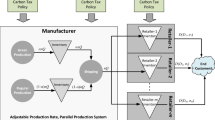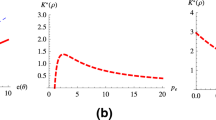Abstract
This paper investigates a production system in which the desired system state is a reduction of emissions and the controlling action plan is altering carbon price. From the operations perspective, we develop a model to study how increasing carbon emission costs may affect the joint production and location decisions for a manufacturer across different locations. Specifically, our model incorporates economies of scale and explicitly links product demand, production costs and carbon emission levels to location decisions. The firm's decisions in production batch size and locations are then optimised. The system state of emission are analysed under different carbon prices. Finally we check the alignment of objectives in costs and emissions for the system. The results show that for a production system with economies of scale, the production allocation is transformed to a location choice problem after optimising the costs. Raising the carbon price reduces the carbon emissions but may not be able to induce the production to be placed in an emission efficient place. We propose a hybrid policy combining carbon price and free emission allowance to fully align the cost efficiency and emission efficiency and characterise the link between the emission target and the carbon price.
Similar content being viewed by others
References
Baldwin, R. & Venables, A.J. (2013). Spiders and snakes: offshoring and agglomeration in the global economy. Journal of International Economics, 90(2): 245–254.
Böhringer, C. & Rutherford, T.F. (1997). Carbon taxes with exemptions in an open economy: a general equilibrium analysis of the german tax initiative. Journal of Environmental Economics and Management, 32(2): 189–203.
Bonney, M. & Jaber, M.Y. (2011). Environmentally responsible inventory models: non-classical models for a non-classical era. International Journal of Production Economics, 133(1): 43–53.
Cachon, G.P. & Harker, P.T. (2002). Competition and outsourcing with scale economies. Management Science, 48(10): 1314–1333.
Chen, X., Benjaafar, S. & Elomri, A. (2013). The carbon-constrained EOQ. Operations Research Letters, 41(2): 172–179.
Conant, R.C. & Ashby, R.W. (1970). Every good regulator of a system must be a model of that system. International Journal of Systems Science, 1(2): 89–97.
Desmet, K. & Rossi-Hansberg, E. (2015). On the spatial economic impact of global warming. Journal of Urban Economics, 88: 16–37.
Economist. (2013). Carbon copy: some firms are preparing for a carbon price that would make a big difference. Available via Economist URL. http://www.economist.com/news/business/22159160-some-firms-are-preparing-carbon-price-would-make-big-difference-carbon-ccop.
Economist. (2015). Local policies can combat emissions where international ones fall short. Available via Economist URL. http://www.economist.com/news/international/21679695-mayors-turn-local-policies-can-combat-emissions-where-international-ones-fall-short.
Gaussin, M., Hu G.P., Abolghasem, S.P., Basu, S., Shankar. M.R. & Bidanda, B. (2013). Assessing the environmental footprint of manufactured products: a survey of current literature. International Journal of Production Economics, 146(2): 515–523.
Gong, X.T. & Zhou, S.X. (2013). Optimal production planning with emissions trading. Operations Research, 61(4): 908–924.
Grossman, G.M. & Rossi-Hansberg, E. (2008). Trading tasks: a simple theory of offshoring. The American Economic Review, 98(5): 1978–1997.
Hua, G.W., Cheng, T.C.E. & Wang, S.Y. (2011). Managing carbon footprints in inventory management. International Journal of Production Economics, 132(2): 178–185.
Kim, T., Hong, Y. & Lee, J. (2005). Joint economic production allocation and ordering policies in a supply chain consisting of multiple plants and a single retailer. International Journal of Production Research, 43(17): 3619–3632.
Krass, D., Nedorezov, T. & Ovchinnikov, A. (2013). Environmental taxes and the choice of green technology. Production and Operations Management, 22(5): 1035–1055.
Krugman, P. R. (1991). Geography and Trade. MIT press.
Li, S.D. & Gu, M.D. (2012). The effect of emission permit trading with banking on firm’s production–inventory strategies. International Journal of Production Economics, 137(2): 304–308.
McCann, P. (1996). Logistics costs and the location of the firm: a one-dimensional comparatives static approach. Location Science, 4(1): 101–116.
Nidumolu, R., Prahalad, C.K. & Rangaswami, M.R. (2009). Why sustainability is now the key driver of innovation. Harvard Business Review, 87(9): 56–64.
Owen, S.H. & Daskin, M.S. (1998). Strategic facility location: a review. European Journal of Operational Research, 111(3): 423–447.
Pacala, S.W. & Socolow, R.H. (2004). Stabilization wedges: solving the climate problem for the next 50 years with current technologies. Science, 305(5686): 968–972.
Plambeck, E.L. (2012). Reducing greenhouse gas emissions through operations and supply chain management. Energy Economics, 34: S64–S74.
Stern, P.C., Sovacool, B.K. & Dietz, T. (2016). Towards a science of climate and energy choices. Nature Climate Change, 6(6): 547.
Umpleby, S.A. & Dent, E.B. (1999). The origins and purposes of several traditions in systems theory and cybernetics. Cybernetics & Systems, 30(2): 79–103.
Victor, D.G. & Kennel, C.F. (2014). Climate policy: ditch the 2°C warming goal. Nature, 514(7520): 30–31.
Wahab, M.I.M. & Mamun, S.M.H., Ongkunaruk, P. (2011). EOQ models for a coordinated two-level international supply chain considering imperfect items and environmental impact. International Journal of Production Economics, 134(1): 151–158.
Acknowledgments
This research is supported by the National Science Foundation of China (No. 71401117, No 71340007). The authors thank the editor and the anonymous referees whose comments and suggestions have significantly improved the quality of the paper.
Author information
Authors and Affiliations
Corresponding author
Additional information
Peng Wu is an associate professor in Sichuan University. He obtained his Ph.D. in Tsinghua University in 2010. His research interests include low-carbon operations management and supply chain management.
Jiuping Xu is a professor in Sichuan University. He obtained his Ph.D. of applied mathematics from Tsinghua University, Beijing, China; and Ph.D. of physical chemistry from Sichuan University, Chengdu, China, in 1995 and 1999, respectively. Prof. Xu has been appointed as an Academician of the International Academy of Systems and Cybernetic Sciences since 2010. He is also the Honorary Academician of Academy of Sciences of Moldova, and the Foreign Academician of Mongolian National Academy of Sciences. He has published over 40 books by Springer, Taylor & Francis, and over 400 international peer-reviewed journal papers in areas of uncertainty decision making, systems engineering, economic theorem, and information science. His current research interests include low carbon economics, uncertainty decision making, and complex systems with applications.
Rights and permissions
About this article
Cite this article
Wu, P., Xu, J. Emission abatement for production system across locations with heterogeneous emission profiles. J. Syst. Sci. Syst. Eng. 26, 531–548 (2017). https://doi.org/10.1007/s11518-017-5338-4
Published:
Issue Date:
DOI: https://doi.org/10.1007/s11518-017-5338-4




